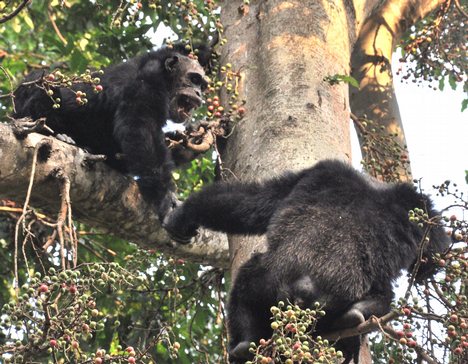War and Terrorism in the Animal Kingdom

Animals Waging War
Among the most grievous charges against the human race is war. The German writer Hans Magnus Enzens-berger started his book on European civil war by saying, "Animals fight, but they do not wage war." We should be ashamed by the presumption that animals don't make war. However, other animals actually do. Ant wars are the best known, but insects are sufficiently different to us that people rarely take that to heart. In recent years it has become clear that animals as intimately related to us like chimpanzees can go to war. The famed chimps of Gombe attack other bands without any provocation and with deadly intent, not just patrolling their borders but devising raids. They could kill and eat each other.
One report, which involves both terrorist behavior and a sudden detection of commonality, is especially reminiscent of human warfare. When a group of chimpanzees from Gombe's Kasakela group discovered a strange female and her infant in a tree, they barked menacingly. After a few blows had been geared at her, there was a break, during which some of the chimps fed in the same tree. She drew close to one of the males submissively and touched him, but he made no reaction. When she tried to leave, a lot of the males blocked her way. She came near another male, Satan, submissively and once again touched him. His reaction, in an evidently xenophobic gesture, was to pick some leaves and use them to scrub the spot she just touched. Instantly several chimpanzees attacked her and seized her infant. For eight minutes she struggled unsuccessfully for her baby, and eventually escaped, badly injured. One of the Kasakela apes banged up the infant against trees and rocks and cast her down. She was not dead, and Satan picked her up softly, groomed her, and placed her down. Over the next few hours, three other males, including Satan, carried the infant tenderly, supporting and grooming her, before she was left to die of her wounds. It's difficult to know what to make of this unusual story. Is it possible to attribute regret, a feeling that they had gone too far, to these chimpanzees? Did they feel first hatred, then pity, as warring humans occasionally do? In other face-offs between bands, infants have been killed and eaten. This incident points out mixed feelings, in which the infant went from being "enemy" to "baby."
Bands of dwarf mongooses likewise join battle, evidently over territory. Several are injured, and some die. One battle started out with the appearance in one group's territory of a different group. Each band gathered, twittered, groomed, and labeled each other with scent. Then the resident group went ahead as a body and was encountered by the other group. The "armies" advanced and backed out, then abruptly began sinking their teeth into each other. At one point both bands moved back as if in truce, then swept back into battle. Finally the invaders withdrew. None of the resident mongooses was killed, although toes had been bitten off, ears chewed to stumps, a tail broken. One was injured so severely that she could no longer feed herself and later died. In their second clash this same group lost.
These mass struggles seem to be over territory. One group intrudes on another's territory and battle is joined. Hans Kruuk observed combat between spotted hyenas, which happened when members of one clan killed prey in the other clan's range. Such quarrels were generally won by the residents, after extended threats and chasing, but occasionally the conflict intensified, and hyenas were hurt or killed. Once, to Kruuk's horror, a hyena whose clan had killed a wildebeest on another clan's range was fatally injured. His assailants bit off his ears, feet, and testicles, and left him bloody, paralyzed and partly eaten.








